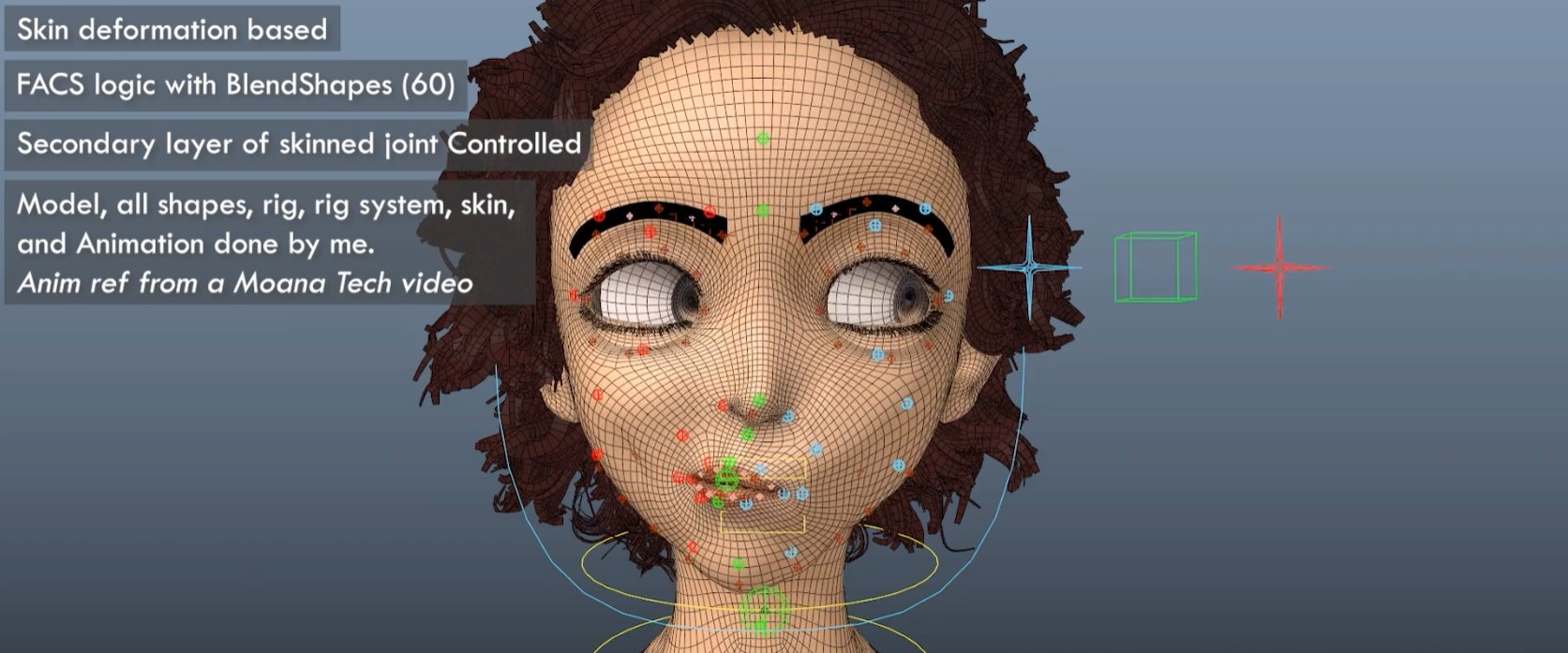This article is also available in:
![]() Français
Français
Illumination Mac Guff, Sony, Method Studios, Pixomondo… Over the span of his career, rigging expert Nims Bun has had the opportunity to work in many studios.
In this interview, he tells us about his first steps in the industry, his career path but also his work on Baguette, a nodal rigging system for Maya he developped. He also gives us his take on the future of rigging, and the impact emerging technologing might have: the rise of game engines in the VFX world, AI, deep learning.
3DVF: Hello Nims, and thanks for this interview! You have over 15 years of experience as a Character TD / rigger. Can you tell us about your background? Why did you decide to focus on rigging, and what are the main milestones of your career?
Nims Bun: Hello there, I’m a French and Canadian rigger. I grew up in France in the 80’s and 90’s watching a lot of Japanese animation and I started drawing very early. I was also pretty good in school with anything related to science so I always knew I wanted to do something related with maybe math and art but couldn’t put something on it yet. In a job and school convention I came across this new school called École Georges Méliès (called EESA at the time) with fantastic people who were doing 3D Animation. It grew in me and I knew I wanted to do that. After receiving my Bachelor of Animation I started as an animator. When I was working as an animator, one of the first things that struck me was “hmmmm it would have been better if this control was doing that or we could have something there”, but nobody could do it for me, so I did it … I loved it and I switched to being a full time rigger! At the time we were not that much riggers so it was easy to find jobs haha.
All my gigs were important for me but if I have to define the main milestones of my career I would say:
- 2007 working for Arkane Studios. It was challenging, and also a giant sandbox for me where I experimented a lot! I have some of the best memories of my career.
- 2014 working at Sony Pictures ImageWorks in Vancouver Canada. It was the first time I was leaving France in a country and city I knew nothing about. The people I was working with are absolutely the best.
- 2017 – I stepped up as Creature Supervisor at Method Studios. I’ve learned what it means to be in charge of a big team. I mean it’s a lot of meetings and scheduling and I still have my hands in doing rigs and shots.
- 2018 – Where Baguette my rigging tool really bloomed at Pixomondo.
3DVF: While working at Method Studios, you worked on The New Mutants as a Creature Supervisor. Can you tell us about the work done by your team on this show?
As a creature supervisor on this show I was taking care of the rigging team and also the creature FX (cloth/hair simulations). So we were taking care of the Rahne/Wolfsbane’s growing hair shots, the Roberto/Sunspot with firing hair, Samuel/Cannonball getting speed, the bear (rig, facial rig, body sim setup, shotfix sim) and a lot of other smaller assets. Production wise I would say it was pretty easy to work with Franck Belina (CG supervisor), Craig Wentworth (VFX supervisor) and all the production team.
The main challenge was probably adapting our digital version of Rahne (played by Maisie Williams) in our shots with her growing hair, keeping it realistic. Working with the bear was pretty fun, who doesn’t love working on a big angry creature?
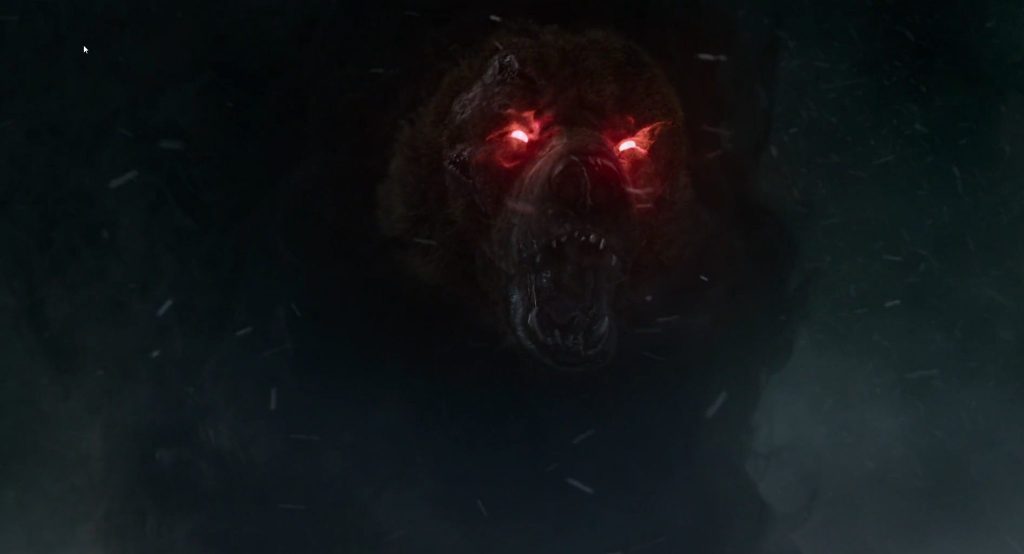
3DVF: More recently, at Pixomondo, you were Rigging Lead on Midway. What were the main challenges faced by the team & yourself?
In a few words I would say, there are tons of digi doubles and tons of different planes on Midway. The goal was to have everything as realistic as possible. So every digi double ended up having a complex face rig. The director of Animation Sebastian Butenberg is also a huge plane fan and wanted every part of the planes to be animated like a real plane. For example on every propeller of every plane we added a real speed attribute, a real folding landing gear …
All the project was handled with Baguette for the rigging side. It was also the first project Baguette had to deal with face rigs.
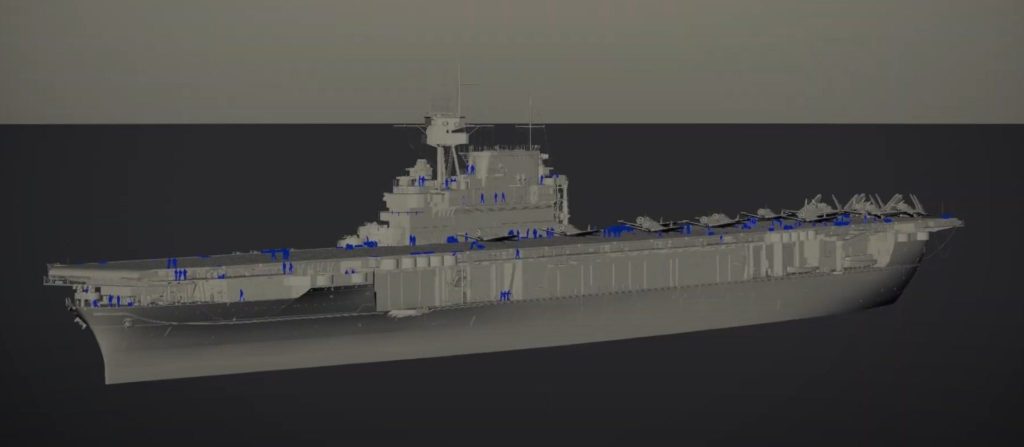

3DVF: While you were at Pixomondo, you worked on Baguette, a rigging system for Maya which has been used in their various facilities. Can you tell us about it? What can/can’t be done with it?
Baguette took a few years to develop and I called it Baguette when I was at Pixomondo. It’s a nodal interface allowing you to create any rig possible the way you want. You can use a chain node, set it to 4 joints and say it’s a finger. You can edit the shape by a predefining list or completely deform the way you want with the color you want and save it. Each node is independent which means if you have two nodes parented to each other, you can still modify one without affecting the other. It is particularly useful if you need to edit a complex rig with 50 nodes, you don’t have to rebuild the full rig, just the one you need. You can also easily save your complex rig as a preset. Each preset available (Biped, Quad) is just a collection of nodes connected together.
Baguette has been thought with all the experience I had in rigging and what could be the best system to handle complex rigs with the least hassle for any level of rigger. So it is very junior proof and you don’t need to know code to use it, but it is also very open to code new nodes. It is expansible by design. It can adapt to almost any pipeline.
A lot of different rigs have been created so far using this tool… What can’t be done is the nodes I haven’t written yet like a nice rope node, a wing/feather node. I want to replace all the maya constraints with matrix based nodes too… So many things to do. It’s exciting! And also it is still all Python based, I’ve started his C++ implementation but I’ve never found the time to finish it (ok I’m lazy 😀 ).
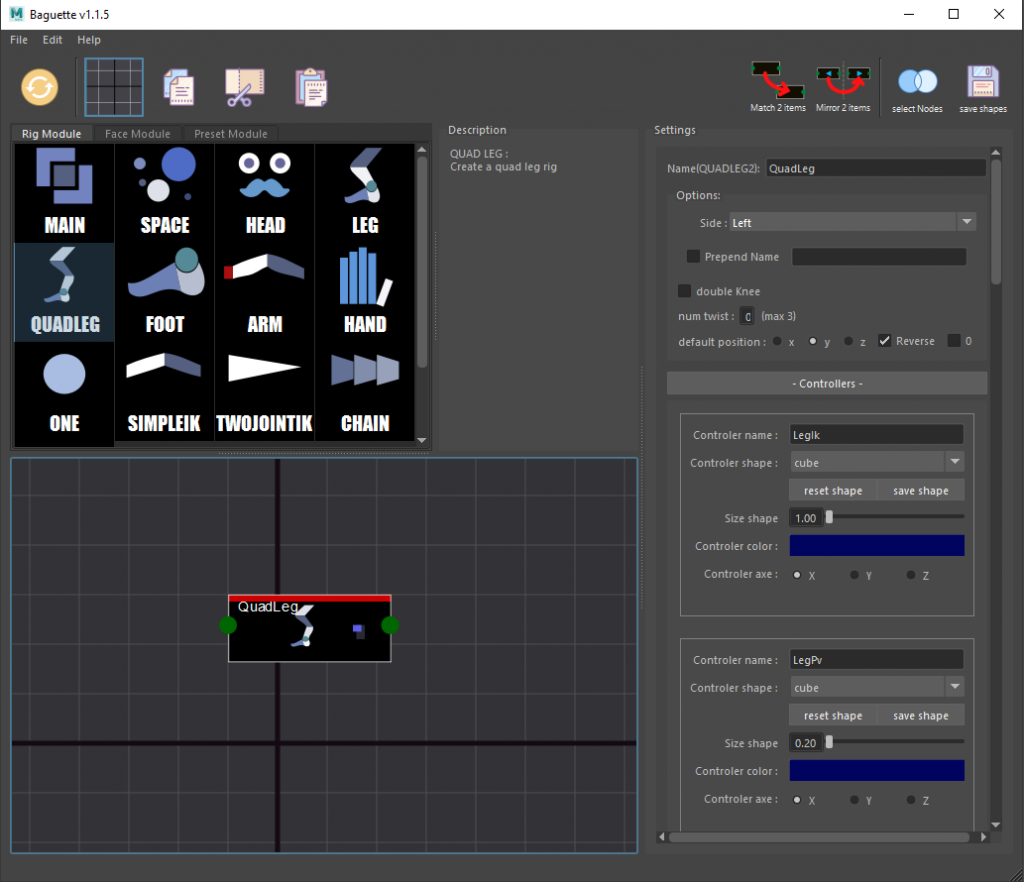
3DVF: This tool actually has a pretty long history, since you started the development in 2013, well before you joined Pixomondo. Why did you launch this project at the time?
So the core and basis for the project was done way before I joined Pixomondo. In 2012, I was wrapping up the movie Minions, and I saw a video of someone creating his own nodal interface to do something in FX … I was like “hey imagine we would have something like that but for rigging?” I was just beginning learning Python at the time, so I took the bull by the horns with this project as a python goal for me. I was fully committed to it in 2013. in 2014 I showed a demo at my interview at Sony and I got hired. Paradoxically I stopped developing at the same time. In 2018 when I arrived at Pixomondo, I was really surprised to find out there was no system I could use, so one of the rigging supervisors of another facility suggested that I write my own or use a free one. I took it as an opportunity to propose my rigging system. Pixomondo trusted me on this one and it was production ready in a few months. The first project was Goosebumps 2, it was not perfect and I needed to fix a ton of bugs with the animation team and the rigger in my team Siting Liu but we did it eventually. Each project forced me to make it better. The biggest milestone was when I found out how to handle more than 100 nodes without being slow to navigate, that was a game changer for us.
3DVF: You also developped a face module preset for Baguette. A few words about it?
When I was at Pixomondo, I let Siting Liu, a talented rigger in my team, handle most of the face rigs. She showed me the limitation of using a single simple node (single joint) and inserting tons of code inside the node (without creating a node of its own) so I basically based the work of new nodes based of how she used Baguette and I came up with nodes who can handle FACS blendshape, secondary sticky controllers skinnable, with a lot of attributes to deal any type of face rig without the need of a single line of code. Once I created those nodes I was able to recreate a full face rig I transformed into a preset.
This preset allowed me to create a face rig in minutes. It would create all the blendshape you need (or not) and you can also just use the interface to add, replace, edit or remove any blendshapes.
3DVF: Who owns the rights of Baguette? Does the tool belong to Pixomondo, or are you free to use it in the future? Is it available for sale?
Baguette is 100% mine. Pixomondo had the right to use the version I allowed them to use. When I was there I didn’t know it was used in other facilities at first. One day a rigger from the other side of the planet came to chat with me and ask me something about a bug he had on Baguette. I was really surprised haha. When I left, to avoid any future conflict I made a deal with the head of studio and VFX sup that Baguette wouldn’t be used anymore (except on the projects it had started with). I never checked if it was still the case or not but it’s not important really. I have a very different version today.
It is not available for sale as it is but I can make a partnership like I did with Amazon Game Studios. I intend to make it available for everyone one day (I don’t know yet how).
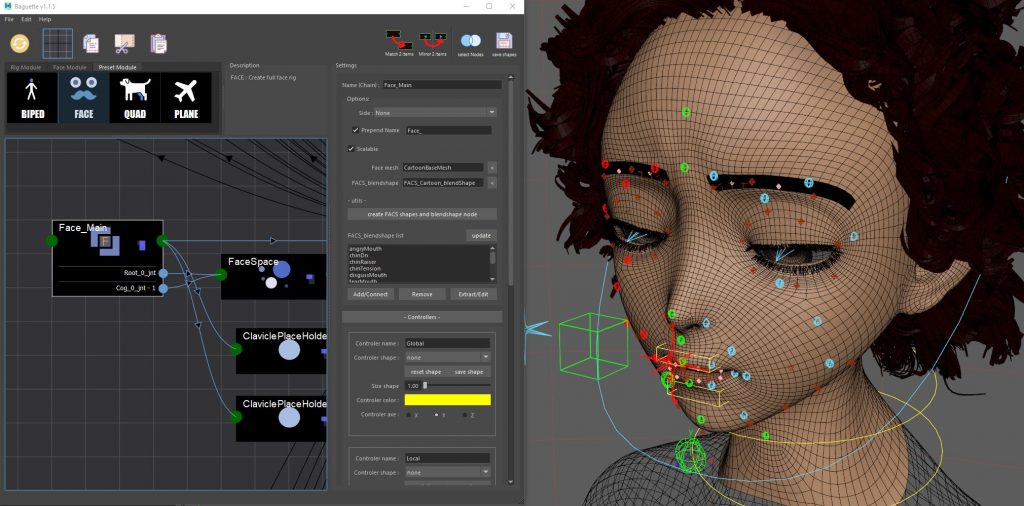
3DVF: Our industry is a fast-evolving one. AI, deep learning have a growing impact on the tools used in the studios. What is your take on this ? And where do you think rigging is headed?
This is fascinating, I badly want to put my hands into it as a rigger. I am not the best to talk about it but from what I see so far is we barely scratched the surface of what we can do to automate certain processes. Let’s take a biped human model in a production environment. I’ve seen something who can detect an arm, face, body, place joints and skin it. It’s great, and a great beginning but so many things need more manual refinement. What if you have a custom rig, one more limb on a creature, how do you know if it’s an arm or a tail? and without going to this extreme detail, your joint placement needs to make sense depending if it’s a shoulder or an elbow, it cannot be on the “middle average” of the mesh … So to refine the deep learning process you will need to feed tons of data. We are very far from achieving a full complex custom rig without human intervention so I think riggers still have good days ahead of them.
3DVF: Can you also tell us about your thoughts on real-time technologies, such as Unity, the Unreal Engine, MetaHumans, especially when it comes to rigging?
Game engines are taking over the world of VFX. Unity buying Weta, Unreal Engine used on projects like The Mandalorian which is heavily VFX based…
I can’t deny it is scary for someone like me who is a big Maya user but in the end this is just another sandbox with different tools to produce more tools and assets for animation. A lot of the veteran animators in the industry don’t want (or won’t) leave Maya soon. And the animation tools for now in those real time engines are not close to what we have in Maya. It doesn’t mean it will stay like that forever… But it reminds me of Houdini when the new UI came out around 2006, it is the best tool for any kind of simulation and some were thinking it would be a Maya/Max killer but it lacked some solid animation and rigging tools. I think today you can completely do rig, animation and CFX on Houdini, but it needs a solid pipeline built around it and not many houses are doing the jump. I know for example Digital Domain has been building the CFX pipeline on Houdini since very recently. My point is real-time technologies are not replacing what we have but it opens a lot of opportunities for riggers today!
3DVF: How do you envision the future of your career?
This is a tough question but from here I see 3 different paths. One is I continue doing more development and I become 100% rigging TD/Developer. Another possibility is I keep taking more responsibility and drive more rigging teams. The third and last one is to be on the more creative side of things and jump to try to be Director of Photography on set (so first CG sup? then VFX sup?) as my other passion is photography and studio lighting.

3DVF: One last question. Do you have any advice for students willing to become riggers?
If you’re still in school, be nice with everyone, they are your future co-workers. Building your network has already started. They will be the one to say one day “I know this guy from school, nice with everyone and hard worker” (hopefully :D).
For rigging more specifically, do every tutorial you can, learn Python as soon as you can, knowledge is power. The secret ability every rigger should know is to learn animation. This is the best way to understand an animator. So do a rig and animate it yourself and ask yourself what you would do or like if you were an animator.
More Information
- Nims Bun’s profile on LinkedIn.

